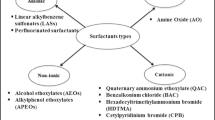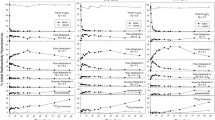Abstract
The impact of surfactants on naphthalene and phenanthrene biodegradation and vice versa after surfactant flushing were evaluated using two anionic surfactants: sodium dodecyl sulfate (SDS) and sodium dodecyl benzene sulfonate (SDBS); and two nonionic surfactants: POE (20) sorbitan monooleate (T-maz-80) and octylphenol poly(ethyleneoxy) ethanol (CA-620). Naphthalene and phenanthrene biodegradation varied differently in the presence of different surfactants. Naphthalene biodegradation was not impacted by the presence of SDS. In the presence of T-maz-80 and CA-620, naphthalene biodegradation occurred at a lower rate (0.14 d-1 for T-maz-80 and 0.19 d-1 for CA-620) as compared to un-amended control (0.29 d-1). Naphthalene biodegradation was inhibited by the presence of SDBS. In the presence of SDS, phenanthrene biodegradation occurred at a lower rate (0.10 d-1 as compared to un-amended control of 0.17 d-1) and the presence of SDBS, CA-620 and T-maz-80 inhibited phenanthrene biodegradation. The surfactants also responded differently to the presence of naphthalene and phenanthrene. In the presence of naphthalene, SDS biodegradation was inhibited; SDBS and T-maz-80 depleted at a lower rate (0.41d-1 and 0.12 d-1 as compared to 0.48 d-1 and 0.22 d-1). In the absence of naphthalene, CA-620 was not degradable, while in the presence of naphthalene, CA-620 began to degrade at a comparatively low rate (0.12 d-1). In the presence of phenanthrene, SDS biodegradation occurred at a lower rate (1.2 d-1 as compared to 1.68 d-1) and a similar trend was observed for T-maz-80. The depletion of SDBS and CA-620 did not change significantly. The choice of SDS for naphthalene-contaminated sites would not adversely affect the natural attenuation of naphthalene, in addition, naphthalene was preferentially utilized to SDS by naphthalene-acclimated microorganisms. Therefore, SDS was the best choice. T-maz-80 was also found to be usable in naphthalene-contaminated sites. For phenanthrene contaminated sites, SDS was the only choice.
Similar content being viewed by others
References
Abriola LM,Pennell KD,Pope GA,Dekker TJ & Luning-Prak DJ (1995) Impact of surfactant flushing on the solubility and mobilization of dense nonaqueous-phase liquids. ACS Symp. Ser. 594: 10-23
Anderson GR (1955) Nitrogen fixation by Pseudomonas-like soil bacteria. J. Bacteriol. 70: 129-133
Aronstein BN &Alexander M (1991) Surfactants at low concentrations simulate biodegradation of sorbed hydrocarbons in samples of aquifer sands and soil slurries. Envir. Texico. Chem. 11: 1227-1233
Block SS (1991) Disinfection, Sterilization and Preservation, 5th ed., Lippincott Williams & Wilkins Publishers
Cuny P,Faucet J,Bertrand J-C &Gilewicz M (1999) Enhanced biodegradation of phenanthrene by a marine bacterium in presence of a synthetic surfactant. Lett. Appl. Microbiol. 29: 242-245
Dawson RMC (1985) Data for Biochemical Research, 3rd ed., Oxford Clarendon Press, New York
Fu MH &Alexander M (1995) Use of surfactants and slurrying to enhance the biodegradation of soil components initially dissolved in nonaqueous-phase liquid. Appl. Microbiol. Biotechnol. 43: 551-558
Gabr MA,Bowders JJ &Shoblom KJ (1995) Flushing of polyaromatic hydrocarbons from soil using SDS surfactant. Geotech. Spec. Publ. 46: 1321-1334
Goudar C,Strevett AK &Grego J (1999) Competitive substrate biodegradation during surfactant-enhanced remediation. EE. 125: 1142-1148
Grady CPL,Daigger GT &Lim HC (1999) Biological Wastewater Treatment, 2nd ed., Marcel, Inc., New York
Hedlund BP,Geiselbrecht AD,Bair TJ &Staley JT (1999) Polycyclic aromatic hydrocarbon degradation by a new marine bacterium, Neptunomonas naphthovorans gen. nov., sp. nov. Appl. Environ. Microbiol. 65: 251-259
Karlson U,Rojo F,Van Elsas JD &Moore E (1995) Genetic and serological evidence for the recognition of four pentachlorophenol degrading bacterial strains as a species of the genus Sphingomonas. Syst. Appl. Microbiol. 18: 539-548
Lee K,Kauppi B,Parales RE,Gibson DT &Ramaswamy S (1997) Purification and crystallization of the oxygenase component of naphthalene dioxygenase in native and selenomethioninederivatized forms. Biochem. Biophys. Res.Commun. 241: 553-557
Macur RE &Inskeep WP (1998) Effects of a nonionic surfactant on biodegradation of phenanthrene and hexadecane in soil. Environ. Toxicol. Chem. 18: 1927-1931
Marchesi JR,Russell NR,White GF, &House WA (1991) Effect of surfactant adsorption and biodegradability on the distribution of bacteria between sediments and water in a fresh water microcosm. Appl. Environ. Microbiol. 57: 2507-2513
Riis V,Miethe D &Babel W (1996) A sensitive method for naphthalene oxygenase assay in whole cells. J. Microbiol. Methods. 26: 27-33
Rouse JD,Sabatini DA,Brown RE &Harwell JH (1996) Evaluation of ethoxylated alkylsulfate surfactants for use in subsurface remediation. Water Envir. Res. 68: 162-168
Rouse JD,Sabatini DA,Brown RE &Harwell JH (1993) Minimizing surfactant losses using twin-head anionic surfactants in subsurface remediation. Envir. Sci. Technol. 27: 2072-2078
Schmitt TM (1992) Analysis of surfactants. Marcel Dekker, Inc., New York
Samanta SK,Chakraborti AK &Jain RK (1999) Degradation of phenenthrene by different bacteria: evidence for novel transformation sequences involving the formation of 1-naphthol. Appl. Microbiol. Biotechnol. 53: 98-107
Shiau B,Sabatini DA &Harwell JH (1995) Properties of food grade (edible) surfactants affecting subsurface remediation of chlorinated solvents. Envir. Sci. Technol. 29: 2929-2935
Thibault SL,Anderson M &Frankenberger WT Jr (1996) Influence of surfactants on pyrene desorption and degradation in soils. Appl. Envir. Microbiol. 62: 283-287
Author information
Authors and Affiliations
Rights and permissions
About this article
Cite this article
Chen, G., Strevett, K.A. & Vanegas, B.A. Naphthalene, phenanthrene and surfactant biodegradation. Biodegradation 12, 433–442 (2001). https://doi.org/10.1023/A:1015068930512
Issue Date:
DOI: https://doi.org/10.1023/A:1015068930512




